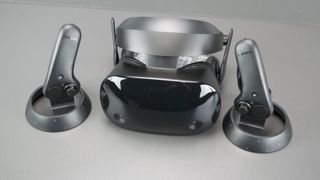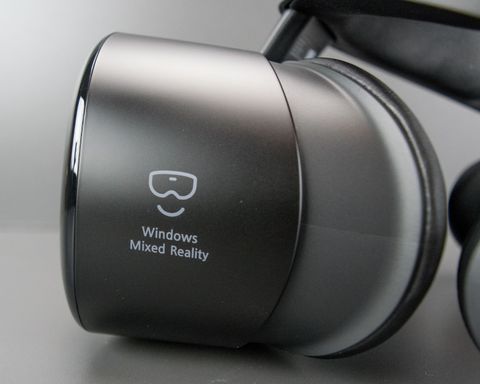Tom's Hardware Verdict
The Samsung Odyssey is the best Windows Mixed Reality headset we’ve seen so far, and we’re confident it is the best option for this generation. It does carry a price premium over the competing Windows MR headsets, but we think the quality of the components justifies the price. And the integrated headphones and microphone help offset the cost difference.
Pros
- +
Best-in-class resolution and image clarity
- +
Integrated 3D audio
- +
Ergonomic controllers
- +
Adjustable lenses
Cons
- -
No flip-visor
- -
Earphone, forehead, rear foam not replaceable
- -
Fixed tether cable
Why you can trust Tom's Hardware
Meet The Samsung HMD Odyssey

Samsung was late joining the Windows Mixed Reality party, but when it finally stopped by, it showed up with the fanciest toys. Samsung's Odyssey HMD is, in some ways, the Cadillac of Windows Mixed Reality headsets. It boasts a higher resolution than other Windows MR HMDs, and it includes built-in headphones that are tuned for 3D audio. It also features moisture-proof leather cushions, and to top it off Samsung redesigned Microsoft's controllers with more thought for ergonomics. If you’re looking for a high-end Windows Mixed Reality headset, the only metric where the Odyssey doesn’t compete well is the price.
Arrived Late With All The Fancy Toys
In late 2016, Microsoft announced that it would be bringing Windows 10 into the immersive computing age. The company revealed Windows Mixed Reality, a platform that encompasses the spectrum of immersive computing. Microsoft boasted that Universal Windows Platform (UWP) apps from the Windows Store would be compatible with the 3D Windows Mixed Reality environment, and that you would be able to do your daily computing tasks while fully immersed in a 3D space.

Along with the announcement of the Windows MR platform, Microsoft revealed that it wouldn’t be making Microsoft-branded headsets. Instead, the company fostered relationships with several PC hardware makers to create Windows Mixed Reality head-mounted displays (HMDs). Microsoft set the hardware specifications for certified devices, and it created a reference design from which to build.
However, Microsoft left it up to its partners to decide what changes they wanted to make to differentiate their device from other Windows Mixed Reality headsets. Microsoft revealed the “Spectrum of HMD Design Freedom,” which outlined the range of specifications that HMD makers could implement. These included minimum resolution, refresh rate, and video and data interface compatibility requirements.
| Row 0 - Cell 0 | Windows Mixed Reality | Windows Mixed Reality Ultra |
| Operating system | Windows 10 Fall Creators Update | Windows 10 Fall Creators Update |
| CPU | Intel Core i5-7200U | Intel Core i5-4590 or AMD Ryzen 5 1400 3.4GHz or better |
| RAM | 8GB | 8GB |
| Storage | 10GB | 10GB |
| GPU | Intel HD Graphics 620 or greater | Nvidia GTX 960/965M/1050 or AMD RX 460/560 or better |
| Display Driver | Windows Display Driver Model 2.2 or later | Windows Display Driver Model 2.2 or later |
| Monitor | External or integrated VGA (800x600) monitor | External or integrated VGA (800x600) monitor |
| USB | USB 3.0 Type-A or Type-C (with adapter), minimum 900mA power | USB 3.0 Type-A or Type-C (with adapter), minimum 900mA power |
| Bluetooth | Bluetooth 4.0 | Bluetooth 4.0 |
Better Specifications
When Microsoft revealed Windows MR in December 2016, Acer, Asus, Dell, HP, and Lenovo were already signed on to build headsets, and they all share relatively similar specifications. Samsung, however, didn’t announce its participation with Microsoft’s Windows Mixed Reality platform until October 2017, but the company brought its A-game when it finally did join the Mixed Reality mix. Samsung disregarded Microsoft’s “Spectrum of HMD Design Freedom” and went for a higher specs altogether. Of all the Windows Mixed Reality devices, the Samsung Odyssey boasts the most premium features. Really, it's in a class of its own.
Most Windows MR headsets feature a pair of 1,440x1,440-resolution displays, whereas Samsung’s displays feature 1,440x1,600 pixels. Also, other Windows Mixed Reality headsets feature LCD panels, while Samsung employs its own AMOLED tech for richer colors and deeper blacks. And Samsung’s Odyssey is the only Windows Mixed Reality HMD with adjustable lens spacing and integrated headphones and a microphone. Samsung is also the only Windows Mixed Reality hardware partner that put the extra effort into refining the motion controllers to make them more comfortable and more robust. Let’s take a closer look.
MORE: Best Virtual Reality Headsets
MORE: All Virtual Reality Content
MORE: Virtual Reality Basics
Current page: Meet The Samsung HMD Odyssey
Next Page An Introduction To Windows Mixed RealityKevin Carbotte is a contributing writer for Tom's Hardware who primarily covers VR and AR hardware. He has been writing for us for more than four years.
-
daviddalke I use my glasses all the time with the Odyssey. The are big and Geeky with progressive lenses (+2.25 for farsightedness). Other than a bit of vertical fuzziness at the bottom due to the progressive lens, I have no issues using it.Reply -
daviddalke The article comments that if you wear glasses to move on. I wear my glasses all the time with my Odyssey. The are big and geeky and have +2.5 progressive lenses. Other than a bit of fuzziness at the bottom of the screen due to the my lenses I have a very enjoyable experience with the Odyssey. I hope Microsoft doesn't abandon their MR effort.Reply -
alextheblue "we would still lean toward an HTC Vive with a Deluxe Audio Head Strap for the most complete VR experience"Reply
Why? Is it the inferior Vive controllers? The sweet last-gen outside-in tracking? Displays? The extra $100 for the DAS? When you make a comment like that, it's nice to point out why. -
Evolution2001 Reply
Here's my reason why I prefer the Vive over the Odyssey.20843150 said:"we would still lean toward an HTC Vive with a Deluxe Audio Head Strap for the most complete VR experience"
Why? Is it the inferior Vive controllers? The sweet last-gen outside-in tracking? Displays? The extra $100 for the DAS? When you make a comment like that, it's nice to point out why.
http://www.tomshardware.com/forum/id-3664417/review-samsung-odyssey-htc-vive.html
-
Evolution2001 Reply
Kevin,20841634 said:Samsung HMD Odyssey Windows Mixed Reality Headset Review: MR Goes Premium : Read more
I believe there was a fairly glaring omission from your otherwise thorough review.
WMR requires Bluetooth 4.0. As BT is more prevalent on laptops than desktops, that might be a gotcha when people get their WMR unit, regardless of manufacturer & model.
"Cool! It's finally arrived!".... "Wait, WTF...I need a BT adapter??? GAHHH!"
Here's a couple of tips that I didn't note in my own review from my month+ spent with the Odyssey.
1) Before anyone purchases any WMR device, you should run Microsoft's WMR PC Check tool. It's a free download in MS' App Store. (HERE) If there's any "X" that it calls out as a problem, WMR will not work. Period.
2) This is the BT adapter that MS officially(?) endorses on their website. Link goes to product on Amazon.
3) I found the controller tracking to be very inconsistent with the Odyssey. In your gaming/testing, did you do much movement where the controllers needed to go to the outer stretches of your arms or behind your head (for games such as Space Pirate Trainer and Beat The Blitz)? My controllers with fully juiced batteries would lose sync which really detracts from the total immersion.
Also, you are correct about the battery cover. As I noted in my review, my grip on the controller was dislodging the battery cover.
4) If my understanding is correct, the controllers pair to your BT adapter. This potentially causes signal attenuation if your BT adapter is plugged into a rear USB port or is simply not always in line-of-sight with the controllers.
5) I too found the tether to be too short. So I ended up buying some extension cables which resolved the problem. Be aware, not all extension cables are created equal. For example, a 'standard' USB extension cable does not infer USB 3.0 compatibility. And WMR is very specific if you aren't plugged into a a USB 3.0 port. I thought maybe it was just power delivery, but I was initially using a powered USB 2.0 extension cord. No go. It has to be a USB 3.0-rated extension cable. Same thing with HDMI certifications.
So here's what I recommend for people looking to extend their playing area. (Obviously, I confirm these work with the WMR headsets, specifically the Odyssey)
- 6' HDMI extension cable- USB 3.0 extension cable- Any run of the mill USB 2.0 extension cable so get your BT adapter closer to the play area.
6) Lastly, with regards to the comparison of built-in audio on the Odyssey compared to the lack-of on the Vive... The Vive has the 1/8" headphone tap on it. A solid set of earbuds fill the need nicely. Their cable drapes over the back of your head and are never in the way. So people don't have to resort to placing big, over-the-ear headphones over the Vive's head strap. I will say that the AKGs on the Odyssey do work exceptionally well!
Again, a nice thorough review. I just wanted to help plug what I consider to be a few holes so the readers can avoid a lot of the delays and headaches that I initially dealt with.
And I also agree- especially given the Vive's price drop since the Vive Pro released- the Vive is still the overall HMD winner.
-
therealduckofdeath I don't see how the 6th point you list is a pro for the Vive, Evolution2001? Using ear-buds can be rather fatiguing when used for extended periods, both the fit and the type of sound you get when it's pumped at your ear drum in a tiny closed pressure chamber. They also create a lot more cable noise than any other option.Reply

